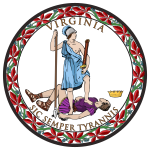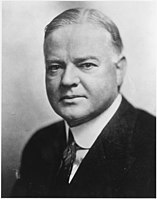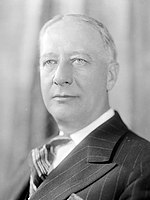| ||||||||||||||||||||||||||
| ||||||||||||||||||||||||||
 County Results
| ||||||||||||||||||||||||||
| ||||||||||||||||||||||||||
| Elections in Virginia |
|---|
 |
The 1928 United States presidential election in Virginia took place on November 6, 1928. Voters chose 12 representatives, or electors to the Electoral College, who voted for president and vice president.
Like all former Confederate States, early twentieth-century Virginia almost completely disenfranchised its black and poor white populations through the use of a cumulative poll tax and literacy tests.[1] So severe was the disenfranchising effect of the new 1902 Constitution that it has been calculated that a third of the electorate during the first half of the twentieth century comprised state employees and officeholders.[1]
This limited electorate meant Virginian politics was controlled by political machines based in Southside Virginia — the 1920 would see the building of the Byrd Organization which would control the state’s politics until the Voting Rights Act. Progressive “antiorganization” factions were rendered impotent by the inability of almost all their potential electorate to vote.[2] Unlike the Deep South, historical fusion with the “Readjuster” Democrats,[3] defection over free silver of substantial proportions of the Northeast-aligned white electorate of the Shenandoah Valley and Southwest Virginia,[4] and an early move towards a “lily white” Jim Crow party[3] meant that in general elections the Republicans retained around one-third of the small statewide electorate,[5] with the majority of GOP support located in the western part of the state. However — like in Tennessee during the same era — the parties avoided competition in many areas by an agreed division over local offices.[2]
Virginia was less affected than Oklahoma, Tennessee or North Carolina by the upheavals of World War I and the Nineteenth Amendment, although there was an unsuccessful challenge to lily-white control of the state’s Republican Party in 1921.[3] During the 1920 and 1924 national Republican landslides, the party did not equal its performances during the first four “System of 1896” presidential elections. Additionally, in 1927 an effort to reduce the cumulative property of the state’s poll tax from three years to two was defeated in committee.[6]
At the beginning of the campaign, prohibitionist Reverend David Hepburn, Superintendent of the Anti-Saloon League of Virginia, predicted a bolt by Virginia, Tennessee and North Carolina due to the religion and Prohibition issues.[7] Governor Byrd would ultimately endorse Smith in August,[8] but the first poll taken in the second week of October had Hoover ahead of Smith by about seven percent.[9] However, around the time of Smith‘s tour of the state in the middle of the month, when he alleged strong links between the state Republicans and the Ku Klux Klan, other pundits said Smith was sure of carrying Virginia.[10]
At the end of October, the consensus was that Smith would carry the state,[11] but Hoover ultimately gained 53.91 percent of Virginia’s vote. This was only the second occasion when Virginia voted for a Republican president, the first being in 1872 during the Reconstruction era. As in all of the former Confederacy, Hoover gained most in the strongly white counties least concerned with black political power,[12] although in the Tidewater and Virginia Peninsula a number of majority-black counties swung unusually strongly against Smith – Charles City County, indeed, gave Hoover two-third of its ballots. Unlike Florida, Texas, or Alabama, Virginia’s swing to the Republicans also saw the GOP gain three House of Representatives seats, including the home district of Byrd.[8]
- ^ a b Kousser, J. Morgan. The Shaping of Southern Politics: Suffrage Restriction and the Establishment of the One-Party South, 1880-1910. Yale University Press. pp. 178–181. ISBN 0-300-01696-4.
- ^ a b Key, Valdimer Orlando (1949). Southern Politics in State and Nation. pp. 20–25.
- ^ a b c Heersink, Boris; Jenkins, Jeffrey A. Republican Party Politics and the American South, 1865-1968. pp. 217–221. ISBN 1107158435.
- ^ Moger, Allen. "The Rift in Virginia Democracy in 1896". The Journal of Southern History. 4 (3): 295–317.
- ^ Phillips, Kevin P.; The Emerging Republican Majority, pp. 210, 242 ISBN 978-0-691-16324-6
- ^ Jaffe, Louis I. (July 1927). "The Democracy and Al Smith". The Virginia Quarterly Review. 3 (3). University of Virginia: 321–341.
- ^ Bonney; The election of 1928 in Virginia (Thesis). p. 39
- ^ a b Hawkes (junior), Robert T. (July 1974). "The Emergence of a Leader: Harry Flood Byrd, Governor of Virginia, 1926-1930". The Virginia Magazine of History and Biography. 82 (3): 259–281.
- ^ "Smith Cuts Down Hoover's Lead in Magazine Poll: With Nearly 2,000,000 Ballots in New York, Governor Reduces Hoover's Lead to 63%". Shreveport Journal. Shreveport, Louisiana. October 13, 1928. p. 11.
- ^ "Klan Tie-Up Laid to G.O.P. Chairman: Virginia Incident Regarded as Rebounding to the Benefit of Smith". The Evening Star. Washington, D.C. October 14, 1928. p. 24.
- ^ "Week In Politics: Summary of National Developments Based on Reports of the Star's Correspondence and Staff Writers". The Evening Star. Washington, D.C. October 28, 1928. p. 25.
- ^ Key junior, Valdimer Orlando. Southern Politics in State and Nation. pp. 323–324. ISBN 087049435X.
© MMXXIII Rich X Search. We shall prevail. All rights reserved. Rich X Search


